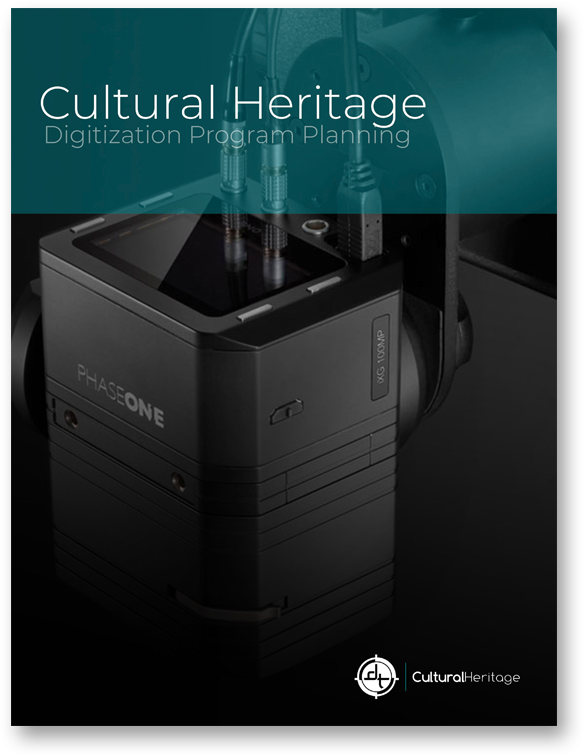Whether you’re scanning flat paper documents, digitizing a library of film negatives, or creating digital copies of your rare book collection, improvements in quality, speed, and cost are a benefit to any institution.
As the leading provider of digitization solutions to clients like National Geographic, The Smithsonian, The National Archives, and The Library of Congress, one of our core missions at DT Heritage is to be a knowledge resource for the digitization community, helping to foster the spread of information and best practices in an industry that too often relies on individuals figuring out techniques and workflows on their own.
As part of that ongoing initiative, we want to share 3 steps (including two eBooks from our Library of Digitization Guides for free – normally $10 for the digital versions or $40 for the hard copies) related to the equipment, software, workflows, and best practices that lead to a better overall results (and investment) in your modern digitization and archival process.
1) Learn How to Utilize Modern Instant-Capture Scanning & Digitization (Free eBook)

While most top-level Galleries, Libraries, Archives, and Museums are currently utilizing camera-based instant capture systems, we often encounter institutions that aren’t knowledgable about the inherent benefits of instant capture systems, and continue to use outdated flatbed or drum scanners for their digitization and archival needs.
With that in mind, we decided to make a brief guide outlining the history of digitization equipment and its evolution into the modern instant capture systems that have become so prevalent.
From a massive increase in repeatable, measurable image quality, to unrivaled speed of workflow, instant capture has become the de facto standard at the world’s leading institutions. If you’ve ever wondered why places like The Getty, The Walt Disney Archive , and The New York Public Library are using instant capture for their digitization projects, this educational guide will walk you through those reasons and benefits. Scroll down to save $10 and download this for free.
2) Plan & Set-up a Modern Digitization Process (Free eBook)
 This Program Planning Guide is intended for those who are involved with organizing or managing digitization programs in gallery, library, archive, and museum institutions. Specifically the focus of this document is on still imaging of real world objects (i.e. paper, sculpture, film, books, art, etc.).
This Program Planning Guide is intended for those who are involved with organizing or managing digitization programs in gallery, library, archive, and museum institutions. Specifically the focus of this document is on still imaging of real world objects (i.e. paper, sculpture, film, books, art, etc.).
We have made every effort to make sure it is useful and informative regardless of the equipment utilized. However, it is especially helpful for those who are using or are considering DTDCH digitization solutions. Specifically we believe that this document will be useful to Program Directors, and other administrators in charge of digitization based on still-imaging. Curators, archivists, program directors, curators, and conservationists can benefit enormously from a deeper understanding of the theory and practice of imaging.
Scroll down to save $10 and download this for free.
3) Learn Modern Workflows for Scanning & Digitization (And Get Certified)
Digitization has undergone a rapid and profound transformation in the past two decades. Legacy systems built on scanning have been replaced with modern instant capture systems. Direct-to-TIFF workflows are being replaced by RAW workflows. Institutions are adopting FADGI and other guidelines that ensure digitization is done at a preservation-grade quality, but require a more nuanced understanding of image quality than relying on manufacturer’s stated PPI. To fully reap the rewards of this transformation requires new hardware, software, and workflows, as well as a new approach to digitization’s position in an institutional context.
Due to this change, we’ve created two courses—DTDC 101: Intro to Modern Digitization and DTDC 201: Operator Training. In the 101 class we take a high-level view of the transformations digitization has gone through to form a solid foundation in the modern approach to digitizing a variety of material types. The 101 course is a fully-online curriculum, and can be taken any time. Graduates of these classes will not only be equipped to handle a modern digitization & archival program, but will also receive a certificate verifying the level of knowledge they’ve attained and be listed on our DT Digitization Certification Graduates Page to create a public record of their achievement.
Next Steps
The level of knowledge and expertise required to run an efficient, comprehensive digitization and archival department can be daunting, so DT Heritage is always available for consultations and evaluations to help guide you towards the best overall solution for your budget and resources. If you’re interested in learning more, please feel free to contact us anytime.
Fill Out This Form to Receive Your Free eBook Bundle
